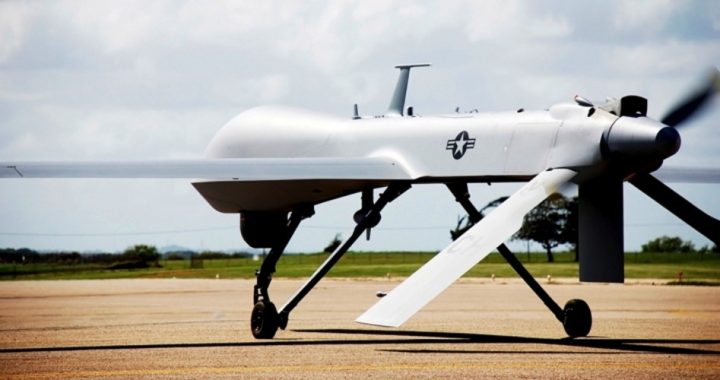
On several occasions President Obama has insisted, along with members of his administration, that drone strikes are used to eliminate only known leaders of the global al-Qaeda network or their colleagues in “associated groups.”
Those statements are false, according to information gleaned by McClatchy newspapers from a leaked classified intelligence report.
The missiles fired from U.S. drones in Pakistan’s mountainous tribal region are killing, along with senior al-Qaeda operatives, “hundreds of suspected lower level Afghan, Pakistani, and unidentified ‘other’ militants,” the secret document reportedly reveals.
In the article announcing its receipt of the classified report, McClatchy reminds readers of an interview the president gave with CNN setting out the guidelines he claims to follow before ordering the assassination of a target by drone. This same interview was covered by The New American last year.
When asked by CNN what process he uses to make the life-or-death decisions to deploy the drones to kill a “militant,” President Obama listed five criteria:
• First, “It has to be a target that is authorized by our laws.”
• Second, “It has to be a threat that is serious and not speculative.”
• Third, “It has to be a situation in which we can’t capture the individual before they move forward on some sort of operational plot against the United States.”
• Fourth, “We’ve got to make sure that in whatever operations we conduct, we are very careful about avoiding civilian casualties.”
• And fifth, “That while there is a legal justification for us to try and stop [American citizens] from carrying out plots … they are subject to the protections of the Constitution and due process.”
McClatchy asserts that the report it has obtained provides evidence that the president routinely ignores his own rules, and is killing “alleged Afghan insurgents whose organization wasn’t on the U.S. list of terrorist groups at the time of the 9/11 strikes; … suspected members of a Pakistani extremist group that didn’t exist at the time of 9/11; and … unidentified individuals described as ‘other militants’ and ‘foreign fighters.’”
In an article in the Atlantic examining the unintended consequences of the protracted, profane, and constitutionally prohibited drone war, Conor Friedersdorf reminds readers that the reprehensible aspects of the drone policy that are known are likely mere tips of an even more unconscionable iceberg of death. Writes Friedersdorf:
Critics of America’s drone war have long insisted that the secrecy surrounding it all but guarantees abuses. How could it be otherwise? CIA agents are permitted to operate as international assassins, killing without any transparent standards, their actions kept secret even after the fact.
In these interviews, the president consistently defends the fact that he orders drone strikes to assassinate people based on nothing more than his suspicion that they threaten U.S. national security. But for all his apparent frankness, there is one aspect of this drone-based assassination program about which the president has remained tight-lipped.
This silence shrouds the cold and callous manner in which civilian deaths are disregarded by the president when it comes to counting the number of fatalities resulting from his death-by-drone campaign. “Mr. Obama embraced a disputed method for counting civilian casualties,” Jo Becker and Scott Shane reported in a New York Times article published May 29, 2012. When read in conjunction with the headline from an Associated Press article reading “Iraq to Stop Counting Civilian Dead,” a picture of global casualness as to casualties begins to emerge.
The Times clarified:
Mr. Obama embraced a disputed method for counting civilian casualties that did little to box him in. It in effect counts all military-age males in a strike zone as combatants, according to several administration officials, unless there is explicit intelligence posthumously proving them innocent. [Emphasis added.]
The highly informative New York Times piece illuminates much of the macabre methodology of aggregating the names of enemies of the state to President Obama’s proscription list.
Recounting the scene at one of the regularly scheduled Tuesday intelligence briefings at the White House, Becker and Shane wrote, “The mug shots and brief biographies resembled a high school yearbook layout. Several were Americans. Two were teenagers, including a girl who looked even younger than her 17 years.”
It cannot be too soberly restated that these seemingly cold-blooded conferences are occurring every week in the Oval Office and are presided over by the president.
That last fact is essential if one is to understand the era into which our Republic has entered. The president of the United States, in this case Barack Obama, sits in a chair in the White House rifling through dossiers of suspected terrorists. After listening to the advice of his claque of counselors, it is the president himself who designates who of the lineup is to be killed. As the New York Times explains:
Mr. Obama has placed himself at the helm of a top secret “nominations” process to designate terrorists for kill or capture, of which the capture part has become largely theoretical. He had vowed to align the fight against Al Qaeda with American values; the chart, introducing people whose deaths he might soon be asked to order, underscored just what a moral and legal conundrum this could be.
According to another investigative report published by the New York Times, it may not be just suspected enemies of the United States being targeted by the president’s drone war; there seems to exist a sort of quid pro quo between the White House and Islamabad regarding the latter’s permission for the former to keep the skies above Pakistan buzzing with Predators. And, if the story is reliable, the mutual backscratching has been going on for years. Consider this story written by Mark Mazzetti:
The target was not a top operative of Al Qaeda, but a Pakistani ally of the Taliban who led a tribal rebellion and was marked by Pakistan as an enemy of the state…. In a secret deal, the C.I.A. had agreed to kill him in exchange for access to airspace it had long sought so it could use drones to hunt down its own enemies. The C.I.A. had been monitoring the rise of Mr. Muhammad, but officials considered him to be more Pakistan’s problem than America’s. In Washington, officials were watching with growing alarm the gathering of Qaeda operatives in the tribal areas, and George J. Tenet, the C.I.A. director, authorized officers in the agency’s Islamabad station to push Pakistani officials to allow armed drones. Negotiations were handled primarily by the Islamabad station. As the battles raged in South Waziristan, the station chief in Islamabad paid a visit to Gen. Ehsan ul Haq, the ISI chief, and made an offer: If the C.I.A. killed Mr. Muhammad, would the ISI allow regular armed drone flights over the tribal areas?
In other words, deploying U.S. drones to kill enemies of allies is a big, juicy carrot tied at the end of the stick of turning a blind eye to murder. Due process is destroyed, sovereignty is sacrificed, and all the “bad guys” are destroyed in a flash of Hellfire missiles. This is the understanding the White House has with Pakistan, and as Friedersdorf asks, “Did the CIA make similar arrangements in other countries?”
Perhaps. But more importantly, in this era of rampant, unrepentant federal overreach and impending domestic drone launch, will the federal government deploy these deadly aircraft to track and target suspects sought by local law enforcement in exchange for state government acquiescence to the mandates of ObamaCare, the federal gun grab, or other deprivations of liberty? Will the launch of drones domestically see a corresponding creation of a Pakistan-style quid pro quo between Washington, D.C., and state lawmakers?
We’ll soon see.
Joe A. Wolverton, II, J.D. is a correspondent for The New American and travels frequently nationwide speaking on topics of nullification, the NDAA, and the surveillance state. He can be reached at [email protected].



